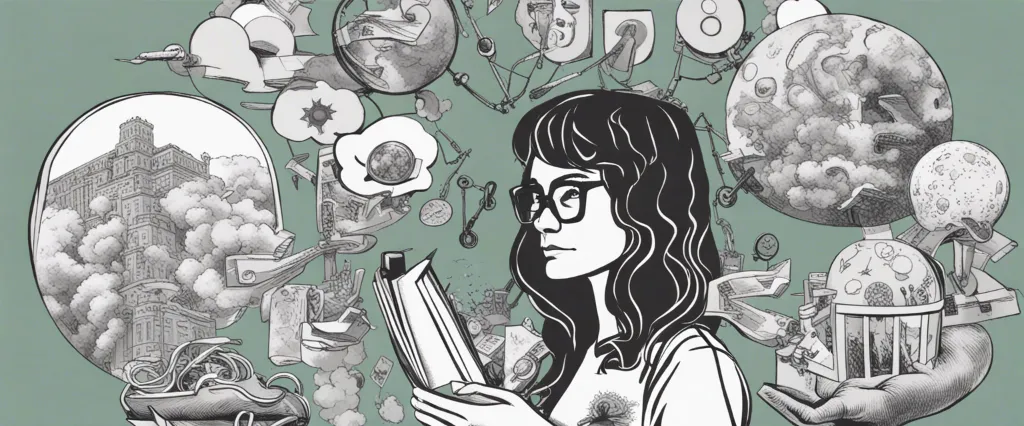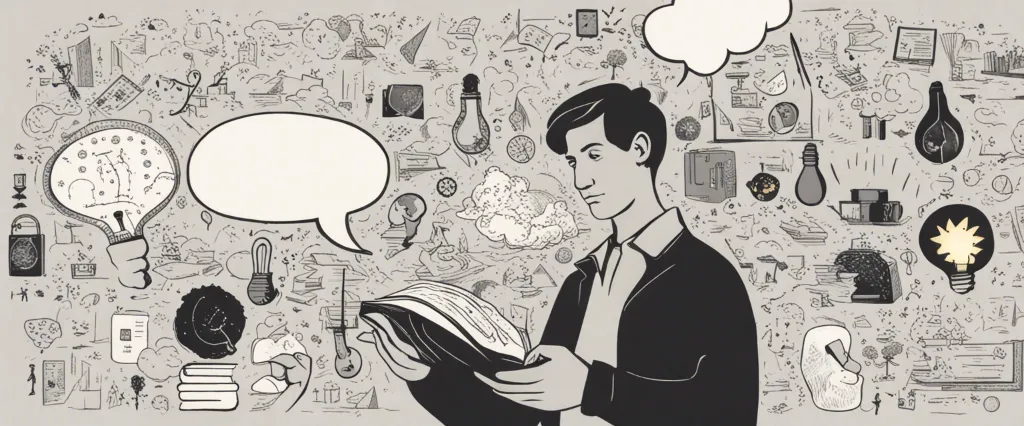In the thought-provoking book “Metamagical Themas,” renowned cognitive scientist Douglas R. Hofstadter embarks on a captivating exploration of the human mind through the lens of mathematics, language, art, and artificial intelligence. With a rare fusion of wit, intellect, and passion, Hofstadter delves into the intricacies of creativity, consciousness, and the interplay between systems, aiming to stimulate readers to question their own perspectives and embrace the wonders of the elusive human intellect.
Douglas R. Hofstadter, born in 1945, is an American professor of cognitive science, computer science, and comparative literature at Indiana University. He is famously known for his groundbreaking work on artificial intelligence and his Pulitzer Prize-winning book “Gödel, Escher, Bach: An Eternal Golden Braid.” Hofstadter’s interdisciplinary approach, combining philosophy, mathematics, and psychology, has earned him international acclaim, consolidating his position as a leading figure in the field of cognitive science. Through his unique blend of rigorous analysis and captivating storytelling, Hofstadter has repeatedly challenged conventional wisdom, inviting readers on a thought-provoking journey into the mysteries of the human mind.
Chapter 1: The Nature of Self-Referential Systems: Exploring the Intricacies of Self-Reference and Recursive Structures
Chapter 1 of “Metamagical Themas” by Douglas R. Hofstadter delves into the concept of self-referential systems and explores their intricate nature. Hofstadter begins by introducing the concept of self-reference, which is essentially the ability of a system to refer to itself or contain elements that refer to itself. He argues that self-reference is a fundamental characteristic of complex systems and plays a crucial role in the emergence of various phenomena.
The chapter examines recursive structures and their connection to self-reference. Recursive structures are those that contain elements repeating or mirrored within themselves. Hofstadter highlights how recursive patterns are found in various domains, such as mathematics, art, and language. For instance, the repetition of a musical pattern within a larger composition or the use of fractals in visual art exemplify recursive structures.
Hofstadter further explores self-referential systems through the lenses of mathematics and logic. He introduces Godel’s incompleteness theorem, which shows that in any consistent mathematical system, there will always be true statements that cannot be proven within that system. This theorem suggests that self-referentiality is inherent in mathematics and that certain truths can only be expressed outside the boundaries of a formal system.
The chapter concludes by emphasizing the significance of self-reference in shaping our understanding of the world. Hofstadter argues that self-reference is not merely an abstract concept but a fundamental characteristic of complex systems, including our own minds. He suggests that the exploration of self-referential systems can help us gain deeper insights into the nature of consciousness, creativity, and intelligence.
In summary, Chapter 1 of “Metamagical Themas” explores the intricacies of self-referential systems and recursive structures. It examines their manifestation in various domains and highlights the role of self-reference in mathematics, logic, and cognition. The chapter raises intriguing questions about the nature of complexity and consciousness, setting the stage for further explorations in the book.
Chapter 2: Gödel, Escher, Bach: A Journey into the Interplay of Mathematics, Art, and Music
Chapter 2 of “Metamagical Themas” by Douglas R. Hofstadter explores the relationship between mathematics, art, and music through the lens of several prominent historical figures: mathematician Kurt Gödel, artist M.C. Escher, and composer Johann Sebastian Bach. The chapter, titled “Contracrostipunctus,” delves into the intricate connections between these disciplines.
Hofstadter starts by introducing Gödel’s incompleteness theorems, which shook the foundations of mathematics in the early 20th century. These theorems revealed the limits and inherent contradictions within any formal system capable of expressing arithmetic. Hofstadter uses Gödel’s theorems as a launching point to explore the concept of self-reference and its influence on art and music.
The author then turns his attention to Escher, a renowned artist known for his mind-bending visual illusions. Escher’s works often feature impossible objects, intricate patterns, and paradoxical situations, demonstrating his fascination with the interplay between different levels of reality, much like Gödel’s theorems. Hofstadter highlights the connection between Escher’s intricate designs and the recursive nature of mathematical systems.
Lastly, Hofstadter explores the music of Bach, particularly his collection of fugues and canons. Through an in-depth analysis of one of Bach’s fugues, known as Contrapunctus XIV, the author reveals the presence of self-referential elements and recursive patterns, mirroring the concepts found in Gödel’s theorems and Escher’s art.
By examining the works of these three genius minds, Hofstadter highlights the common themes of recursion, self-reference, and paradox that pervade mathematics, art, and music. This exploration uncovers the profound interplay between these seemingly disparate disciplines, providing readers with a glimpse into the interconnected nature of human creativity.
Chapter 3: Artificial Intelligence and Machine Learning: Examining the Challenges and Possibilities of Creating Intelligent Machines
Chapter 3 of “Metamagical Themas” by Douglas R. Hofstadter explores the field of Artificial Intelligence (AI) and Machine Learning (ML), delving into the challenges and potential of creating intelligent machines.
Hofstadter commences by highlighting that AI enthusiasts often possess a “grand vision” of creating machines that can think and reason like humans. However, he cautions against such aspirations, arguing that human intelligence is an extremely complex and mysterious phenomenon, making it near impossible to replicate artificially.
The chapter then shifts its attention to the history of AI, tracing its origins back to the 1950s when pioneers like Alan Turing and John McCarthy first conceptualized the possibility of machines capable of intelligent behavior. Hofstadter explores the development of key AI techniques, such as symbolic reasoning and rule-based systems, emphasizing the limitations and flaws associated with each approach.
Next, the focus shifts towards Machine Learning, a subdomain of AI that involves creating algorithms that enable computers to learn and improve from experience. Hofstadter highlights the immense potential of ML, exemplifying its success in areas like speech recognition and image classification. However, he also addresses the challenges faced by ML algorithms, particularly in terms of their inability to truly understand or reason about the data they process.
Hofstadter raises thought-provoking questions regarding the ethical and societal implications of AI and ML. He discusses the potential dangers of autonomous weapons, the implications of AI-driven job displacement, and the ethical considerations surrounding the agency and responsibility of intelligent machines.
Ultimately, while Hofstadter acknowledges the remarkable progress in AI and ML, he urges readers to approach the field with skepticism and emphasizes the importance of understanding the limitations and challenges that lie ahead in the pursuit of creating truly intelligent machines.
Chapter 4: Language and Meaning: Investigating the Relationship between Words, Concepts, and Communication

Chapter 4 of “Metamagical Themas” by Douglas R. Hofstadter explores the intricate relationship between language, concepts, and communication. Hofstadter delves into various aspects of language and meaning, aiming to present a comprehensive understanding of how words are connected to the ideas they represent.
The chapter begins by discussing the fundamental building blocks of language, phonemes. These are the smallest units of sound that combine to form words and convey meaning. Hofstadter explains how different languages utilize different phoneme inventories, leading to variations in pronunciation and ultimately shaping cultures and societies.
The author emphasizes the importance of conceptual metaphor, which involves mapping concepts from one domain to another. For instance, expressions such as “I see what you mean” or “time flies” rely on metaphorical mappings between perception and understanding, or between time and movement.
Hofstadter also explores the idea of polysemy, which refers to words having multiple meanings. He argues that this versatility is an essential feature of language, enabling us to express a wide range of ideas and experiences.
Furthermore, the chapter examines the challenges of communication and how words may be interpreted differently by different individuals. Through examples and anecdotes, Hofstadter illustrates the complexity of meaning and the potential for misunderstandings that can arise from differing interpretations.
In summary, Chapter 4 of “Metamagical Themas” delves into the fascinating interplay between language, meaning, and communication. It explores the role of phonemes, conceptual metaphor, polysemy, and the challenges of interpretation, providing insights into the intricacies of language’s ability to convey ideas and facilitate understanding.
Chapter 5: Consciousness and Cognition: Delving into the Mysteries of Human Thought and Awareness
Chapter 5 of Metamagical Themas by Douglas R. Hofstadter titled “Consciousness and Cognition: Delving into the Mysteries of Human Thought and Awareness” explores the complexities of consciousness and cognition.
Hofstadter begins the chapter by discussing the well-known philosophical question of what it means to be aware and conscious. He acknowledges that while science has made significant progress in understanding many aspects of the human mind, the nature of consciousness still remains elusive and mysterious. He posits that one reason for this is the inherent difficulty in defining and measuring consciousness since it is subjective and unique to each individual.
The chapter then dives into various thought experiments and scenarios that shed light on the nature of consciousness. Hofstadter discusses concepts such as the Chinese Room argument, where a non-Chinese speaker can simulate understanding Chinese simply by following a set of rules, raising questions about the true nature of understanding and consciousness. He also examines the Turing Test and its significance in assessing machines’ ability to exhibit human-like intelligence and consciousness.
Throughout the chapter, Hofstadter interweaves his own thoughts and reflections on consciousness, discussing the limitations of formal systems in fully capturing the nuances of human thought. He delves into the notion of self-referential systems, exploring how self-representation and recursion play a crucial role in shaping our conscious experiences.
In summary, Chapter 5 of Metamagical Themas delves into the perplexing topics of consciousness and cognition. Hofstadter offers thought-provoking insights into the nature of consciousness through various philosophical and thought experiments, shedding light on the mysteries that still remain unsolved in the realm of human thought and awareness.
Chapter 6: Creativity and Inspiration: Exploring the Sources and Mechanisms of Innovative Ideas and Artistic Expression
Chapter 6 of the book “Metamagical Themas” by Douglas R. Hofstadter delves into the fascinating topic of creativity and inspiration. Hofstadter explores the sources and mechanisms that contribute to the generation of innovative ideas and artistic expression.
The author begins by emphasizing the importance of inspiration in creativity and highlights that ideas and insights often come to us in moments of relaxation and idleness rather than during focused, effortful thinking. He elaborates on the role of subconscious processing in the incubation of ideas, drawing upon examples from scientific discoveries and artistic creations.
Hofstadter then delves into the concept of analogy as a powerful tool for creative thinking. He discusses how analogical thinking allows us to draw connections between seemingly unrelated domains, leading to innovative ideas and lateral thinking. Analogy plays a crucial role in solving problems and generating novel perspectives.
Furthermore, the author explores the concept of playfulness and its role in fostering creativity. Playfulness lends itself to open-mindedness and a willingness to explore unconventional paths, ultimately giving rise to unique and imaginative ideas.
Hofstadter also touches upon the relationship between creativity and intelligence, debunking the myth that high IQ is a prerequisite for creative thinking. He argues that creativity can manifest in various forms and highlights the significance of diverse perspectives in the creative process.
To conclude, Chapter 6 of “Metamagical Themas” delves into the sources and mechanisms of innovative ideas and artistic expression. Through discussions on subconscious incubation, analogical thinking, playfulness, and the relationship between creativity and intelligence, Hofstadter provides valuable insights on unraveling the complexities of creativity and inspiring readers to foster their own imaginative abilities.
Chapter 7: The Philosophy of Mind: Considering the Philosophical Implications of Cognitive Science and Neuroscience
Chapter 7 of “Metamagical Themas” by Douglas R. Hofstadter explores the philosophical implications of cognitive science and neuroscience in relation to the philosophy of mind. The chapter is titled “The Philosophy of Mind: Considering the Philosophical Implications of Cognitive Science and Neuroscience” and delves into the connections between our mental processes and the workings of the brain.
Hofstadter begins by discussing the historical perspective on the philosophy of mind, highlighting the long-standing debate between dualism and materialism. He argues that advancements in cognitive science and neuroscience provide compelling evidence to support a materialist view of the mind, suggesting that mental phenomena are nothing more than physical processes occurring within the brain.
The chapter explores various aspects of the mind, such as perception, memory, consciousness, and self-awareness. Hofstadter presents thought-provoking questions on whether these mental processes can be entirely explained through the physical processes of the brain or if there are inherent limitations to our understanding.
Furthermore, Hofstadter discusses the concept of identity and personal experience, raising questions about the nature of identity and what constitutes the self. He emphasizes the importance of analyzing personal experiences and how they are constructed by the brain.
Throughout the chapter, Hofstadter provides examples and thought experiments to illustrate his points, including the famous “Chinese Room” experiment. He also delves into the limitations and challenges faced by cognitive science and emphasizes the need for interdisciplinary approaches to understand the complex nature of the mind.
In summary, Chapter 7 of “Metamagical Themas” explores the relationship between cognitive science, neuroscience, and the philosophy of mind. Hofstadter presents arguments in favor of a materialist perspective and raises intriguing questions about the nature of mental processes, identity, and consciousness. The chapter serves as a comprehensive examination of the philosophical implications arising from the advancements in cognitive science and neuroscience.

Chapter 8: The Limits of Computation: Reflecting on the Boundaries and Potential of Computational Systems
In Chapter 8 of “Metamagical Themas” titled “The Limits of Computation: Reflecting on the Boundaries and Potential of Computational Systems,” Douglas R. Hofstadter explores the fundamental limits and potential of computational systems.
Hofstadter begins by discussing the concept of “stupidity” in computation. He argues that even the most advanced computational systems can be inherently stupid in certain domains, as they tend to lack real understanding and are limited to following predefined rules. He highlights that true intelligence requires insight and understanding, which cannot be replicated by computational systems.
Next, Hofstadter delves into the topic of computability and the famous notion of “Turing completeness.” He introduces various computational models, such as Turing machines and cellular automata, and explains how they can simulate each other. He emphasizes the power and universality of Turing completeness, highlighting that any problem solvable by a human mind can also be solved by a Turing machine.
However, even with the concept of Turing completeness, Hofstadter points out that there are still certain limitations to computation. He explores Gödel’s incompleteness theorems, which demonstrate that there are true statements that are unprovable within a given system. This implies that there are limits to what any computational system can achieve, as there will always exist undecidable problems.
Furthermore, Hofstadter delves into the topic of artificial intelligence (AI) and the challenges faced in replicating human intelligence. While computational systems can perform specific tasks with impressive efficiency, they lack the flexibility, creativity, and intuition that humans possess.
In this chapter, Hofstadter offers an insightful exploration of the boundaries and potential of computational systems, highlighting their limitations in terms of true understanding and insight. He showcases the power of Turing completeness while acknowledging the challenges of replicating human intelligence through computation.
After Reading
In conclusion, Douglas R. Hofstadter’s book, “Metamagical Themas,” explores the enchanting realm of puzzles, paradoxes, mathematics, music, and artificial intelligence. Throughout the book, Hofstadter delves into the complex and fascinating intersections of these diverse topics, inviting readers on a captivating intellectual journey. By combining rigorous analysis with poetic language and playful creativity, Hofstadter challenges our conventional thought processes and expands our understanding of the world. “Metamagical Themas” not only offers thought-provoking insights but also ignites a deep appreciation for the beauty and intricacy of the human mind. Ultimately, the book inspires readers to engage in the magical realms of questioning, exploring, and discovering the infinite possibilities that lie within the realm of human consciousness.
1. “Gödel, Escher, Bach: An Eternal Golden Braid” by Douglas R. Hofstadter – This book, also written by Hofstadter, explores the connections between mathematics, art, and music. It delves into complex topics such as artificial intelligence, consciousness, and the nature of creativity, appealing to readers who enjoyed “Metamagical Themas.”
2. “I Am a Strange Loop” by Douglas R. Hofstadter – Another thought-provoking book by Hofstadter, “I Am a Strange Loop” explores the concept of self and consciousness. It examines how our sense of identity is formed and challenges traditional notions of what it means to be human. If you enjoyed the philosophical discussions in “Metamagical Themas,” this book is a must-read.
3. “The Mind’s I: Fantasies and Reflections on Self and Soul” edited by Douglas R. Hofstadter and Daniel C. Dennett – A collection of essays and thought experiments curated by Hofstadter and Dennett, “The Mind’s I” delves into questions about the nature of the mind, consciousness, and personal identity. It features writings from various thinkers, including philosophers, psychologists, and scientists, making it a captivating read for fans of “Metamagical Themas.”
4. “Mazes for the Mind: Computers and the Unexpected” by Clifford A. Pickover – This book explores the fascinating intersections between computer science, mathematics, and creativity. Pickover takes readers on a journey through the unexpected applications of computers, showcasing mind-bending algorithms and simulations. If you were intrigued by the intersections of technology and creativity in “Metamagical Themas,” this book will captivate your imagination.
5. “Information Theory, Inference, and Learning Algorithms” by David MacKay – For readers interested in the mathematical underpinnings of information theory, this book provides a comprehensive introduction to the subject. MacKay explores concepts such as entropy, coding, and compression, shedding light on how information shapes our understanding of the world. This book is perfect for those who were captivated by the mathematical puzzles and concepts presented in “Metamagical Themas.”




